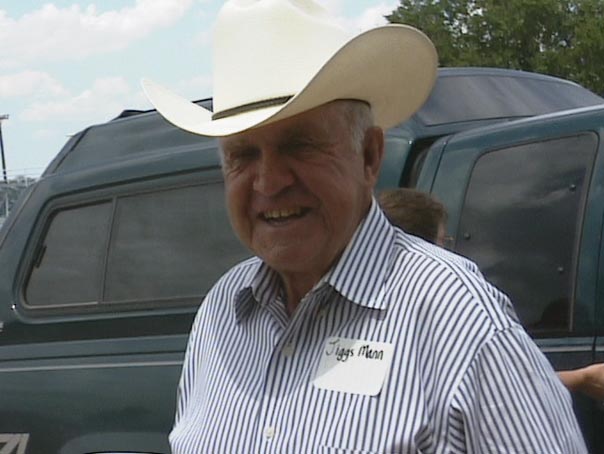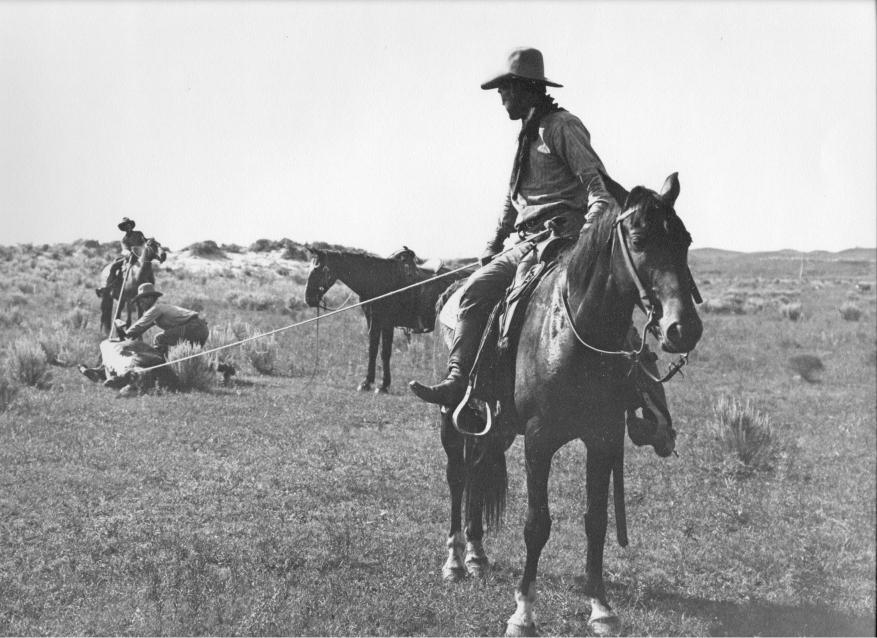

Jiggs Mann passed away in 2016. Many were blessed with his wisdom, humor and kindness. The JA never knew a better friend.
Jiggs Mann first worked for the JA as a schoolboy during the summers in 1942 and 43. Because of the war, there were only boys and old men working at the ranch. He went with the wagon and mostly flanked. "Today, everyone takes a turn at dragging, but then kids only flanked."
Jiggs remembers the wagon, "We would usually go out about the first of May if there had been rain and there was grass. There had to be grass for the horses as that was all the horses had to eat. We'd carry about 10 or 12 horses. Some of them would have 15 or 16. There would be 180 to 200 horses in the remuda. The wagon would stay out until the grass turned in the fall.
"We started at Halls Creek, right there by the first ridge and the wagon would camp there and we'd be there for six to seven days, it would take that many days to work that pasture--Boggy and Tate Arroya and all them was in that drive. Then we'd go to Carroll. Carroll was all one pasture. You might camp on the south side of it and work Hackberry and Carroll together. We'd go to number one, it's sold now, and we'd stay up there seven or eight days. Then we'd come on down to the mouth of Tule to the Barrel pasture.
We'd camp in those pastures and just work a day or two to get enough herd for those traps and then you would have to come out of there. Every third or fourth day, we'd windy out. The only branding we did in the canyon was the heifers. We didn't brand the bulls. They'd be too sore to walk out if we did. Branding the heifers would make them walk good. We'd come in separate herds most of the time, but sometimes we'd bring them out together and split them when you got on top. We'd go to separate pastures with the steer and heifer calves."
Mann makes the separating of the steers and heifers sound simple; however, it is where the talent of a great cowman comes out. The man working the herd rides into the herd while all of the other cowboys hold the herd in a group. The cowman "mammies up" the cows with their calves and eases out the pairs without disturbing the rest of the herd. This means that the man working the herd must be able to recognize the subtle signs that shows when a mother claims her calf.
"That was just routine all the way up and down the river. We'd miss quite a few. Now, some days you'd have a good drive and others, you would miss a lot. You never would go back; you'd just wait and get it the next time. The country was big pastures and they knew approximately how many cattle were in it. We would tally about every year. You would bob the tails and get a count. If you went back to work again that year and found an animal with a tallied tail, you would know it had been counted. You would have quite a few yearlings. That's where the wild cattle started." Upon reflection, Jiggs recognized that there had always been wild cattle on the JA.
"We'd take them back in the fall when we weaned the calves. We'd throw all of those cows together and cut out the feeder cows. They'd leave them in the feed pastures like Churchill. They would go into those pastures around the first of the year and cut out the ones that really needed feed and put them around the Davis place or the other camps and feed them there. Then in March they would go in and cut some more or maybe feed the whole thing.
"In 1950 on new years day, we were cleaning out Turkey Creek and it was near zero. We had worked before Christmas in shirtsleeves. We had a camp and the cook had a big ol' stove and he said, "You boys get us some rocks and I'll heat them for you to put in your bed." We rolled them up in old tow sacks and put one at your feet and one at your stomach and they kept you real warm. But Bobby Thompson got his bed afire."
Winter work was done from bunkhouses at the different camps or from teepees.
Jiggs also remembers when Montie Ritchie had sold the Heckman place and they were moving the cattle off. He was in the remuda with Sunny Long roping out horses and lightening struck and stampeded the herd over the rope pens being held by the cowboys. Neither Jiggs nor Sunny was knocked down.
Another time, they were driving the remuda across Battlecreek. Bob Long was riding in front of the remuda on a horse that he had to fight to keep from running off. A young kid rode out of the herd and loped past Bob. Bob’s horse became a runaway and they lost the whole remuda.
Jiggs says that Bill Beverly probably rode more miles on the JA than anyone else. He was ranch manager under Montie in the 40’s.
Beverly and Montie rode up to a branding at Carroll when Jiggs was just a young kid. Montie rode in to drag and Jiggs thought, “This is going to take all day.” Jiggs said that Montie had a way of trapping the calves and he kept two flanking crews busy.
Mann was considering going to work for Texas & Southwestern Cattle Raisers Association when he returned from Korea in 1953. "I was fixing to go to work for the cattle raisers and Bill Word asked me to come help them ship and I did. He then asked me to run the wagon. He said, "Bud Long is getting in pretty bad shape and I need somebody.' I went out with it for about six months and then took it over until 55 and that's the last time they had it. The screwworms were still bad and the wagon pulled in in the summer. The JA let some of the cowboys run camps and break horses. A fewer of the older hands got off and still got paid. We would go around and and gather groups of cattle and go into the herd and drag out the ones that needed to be doctored."

JA cowboys doctoring a cow, probably for screwworms. Erwin E. Smith
Mann was foreman of the ranch from 1959 to 1969. He leased part of the JA and ran his own cattle until 2002. He presently runs his own ranch outside of Clarendon.
JA owner Ninia Ritchie always considered Jiggs and Evelyn Mann as family.
Cowboy Corner Conversations by Red Steagall has a wonderful interview with Jiggs Mann, as well as many other men. Several of them remember the old JA. We fully recommend it. It and many other great books or CD's of poetry and music are available at http://www.redsteagall.com/. We strongly recommend this book and Ride For the Brand, but you can't go wrong with any of his work.
|
Click on brand to link to another ranch's information. |
||||
 |
 |
 |
||